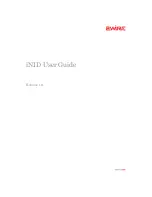
|
Control commands
9
|
devolo MicroLink ISDN i
|
EN
a call (incoming call). The exchange of data between two data stations can
take place during this phase.
A renewed transition to the command phase and back, also in the case of an
existing connection, is possible with the escape command and the command
ATO
. The escape command consists of a series of three escape characters
(default setting: +++) and a valid command line.
After the three escape characters have been entered, the ISDN modem is
already in the command phase. Data transfer is not interrupted until a valid
command line has been recognized.
The escape character has nothing in common with the character
E
of the
ASCII character set. It can be redefined in register S2.
All commands sent to the ISDN modem must begin with the ASCII characters
AT
or
at
(not valid: At or aT) and must be concluded with
M
. A valid com-
mand line in an escape sequence is restricted to a maximum of 40 characters.
The command
AT&F
loads the firmware default parameter settings. The
ISDN modem is thus reset to its factory defaults. This command is not exe-
cuted during existing connections.
2.2
Bit-oriented registers
Bit-oriented registers are primarily used to provide status information.
Please note that the modification of a single value in the bit-oriented register
may have several functions. Great caution should thus be applied when
changing bit-oriented registers! We recommend the use of the AT commands
to change the configuration of the ISDN modem. A complete description of
the S registers can be found in the chapter
'
AT commands: Detailed descrip-
tion'.
2.2.1
Modifying bit-oriented registers
The following example will illustrate the modification of the bit-oriented
options of a register. To set the bit 6 of register S14, enter the command
ATS14.6=1
.
If you would like this value to be maintained after the ISDN modem is
switched off, the new entry can be stored with the command
AT*W
.
Содержание MicroLlink
Страница 1: ...MicroLink ISDN i...










































